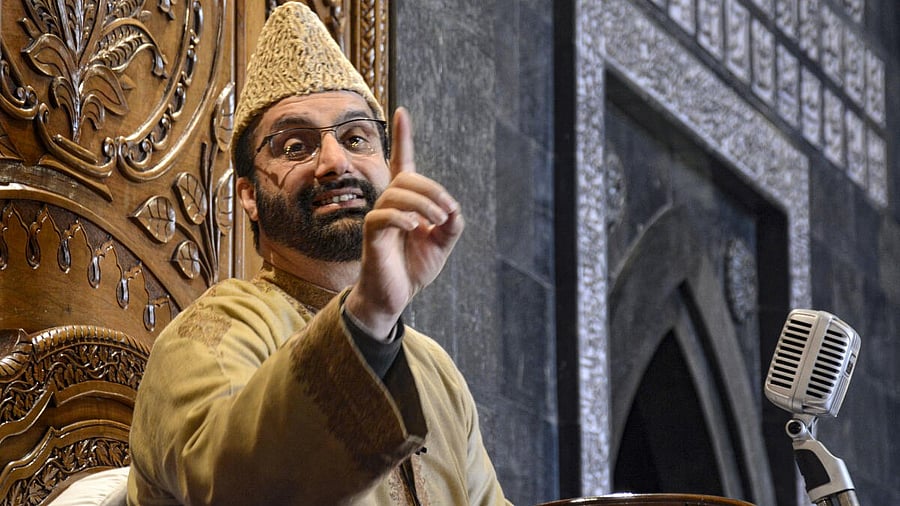
Hurriyat Conference Chairman and Chief Cleric of Jammu and Kashmir Mirwaiz Umar Farooq.
Credit: PTI Photo
Srinagar: The Hurriyat Conference, once a coordinated formidable force in Kashmir’s separatist movement, now faces an uncertain future as its constituents increasingly distance themselves from separatism amid the government's relentless crackdown.
The Hurriyat, which once garnered international attention, securing observer status in the Organization of Islamic Cooperation (OIC) at Pakistan’s urging, seems to have reached a dead end. In the 1990s, diplomats from the US and the EU frequently met Hurriyat leaders to discuss the Kashmir issue.
However, the situation has drastically shifted. The Kashmir conflict no longer matters to the US or the EU. Pakistan has also pulled back its support, making it easier for the BJP government to intensify crackdown on the Hurriyat.
Union Home Minister Amit Shah’s statement that “separatism is breathing its last” in Kashmir is grounded in the shifting realities on the ground, rather than a mere political claim. Just last week, four factions of the Hurriyat publicly renounced separatism, expressing their commitment to the vision of a “new Bharat” under Prime Minister Narendra Modi.
Analysts point out that the Hurriyat’s silence on political developments over the years indicates a loss of influence. “The Hurriyat has become redundant,” said Prof. Noor Ahmed Baba, former head of the political science department at the University of Kashmir. And what are the chances of a revival? “None in the given political context,” he said.
A former Hurriyat leader echoed the same views saying the conglomerate’s future appears bleak. “The banning of its constituents under the UAPA and the continued detention of its leaders have isolated the organization further,” he said. “Its inability to adapt to the changing political realities in Jammu and Kashmir—particularly following the abrogation of Article 370—has left it with little room to maneuver.”
He also said that the Hurriyat is increasingly disconnected from the younger generation, who are more focused on career and economic development.
Hurriyat chairman Mirwaiz Umar Farooq acknowledges that post August 2019, the intense pressure on its constituents and members through raids, bans and arrests has considerably weakened the conglomerate.
“I have always maintained that Hurriyat represents people’s sentiment for resolution of the Kashmir conflict in the light of historical facts. As long as these facts remain and the sentiment in people remains, the need for redressal remains. Hurriyat is not irrelevant as it is not an adversal force but always wants to play a role in restoring peace with dignity,” he told DH.
Hurriyat’s background:
The Hurriyat’s journey from a unified front of political, social, and religious organizations in 1993 to its current fractured state marks a dramatic shift in the region’s separatist movement. The roots of the Hurriyat can be traced back to December 27, 1992, when Mirwaiz, only 19 at the time, led a meeting that ultimately resulted in the formation of All Parties Hurriyat Conference on July 31, 1993.
Initially, the Hurriyat was a broad alliance of over two dozen political, religious, and social organizations that quickly became the face of separatism in Kashmir. The central aim of the Hurriyat was the right to self-determination, a cause that resonated with a significant segment of the Kashmiri population.
However, differences over the role of the armed struggle and the need for peace talks with New Delhi divided the Hurriyat into moderate and hardliner factions led by Mirwaiz and Syed Ali Geelani, respectively. The Mirwaiz faction called for political dialogue and diplomatic solutions to the Kashmir issue, while the Geelani faction adopted a more hardline stance advocating for secession from India.
Although these differences were often overshadowed by the shared goals, the 2003 split between the two factions set the stage for the Hurriyat’s decline. From 2003 onwards, the Mirwaiz faction engaged in dialogue with both the Vajpayee and Manmohan Singh governments, while the Geelani faction continued to support violence and public unrest.
The Hurriyat’s real downfall, however, began after the August 5, 2019 decision by the BJP-led central government to revoke Article 370. This move rendered the Hurriyat’s core demand for self-determination largely irrelevant.
The government’s increasing use of the Unlawful Activities (Prevention) Act (UAPA), a stringent anti-terror law, to target Hurriyat leaders further weakened it, with many key figures arrested or placed under house arrest, splintering the organization further.
Mirwaiz, once considered the moderate face of the Hurriyat, now finds himself marginalized and increasingly scrutinized by security agencies. The death of Geelani in September 2021 dealt another blow to his faction of the Hurriyat, and with key leaders, including Masrat Alam Bhat, imprisoned for 15 years, the Geelani faction has struggled to chart a new course.
A senior journalist who has covered the separatist movement for decades remarked that the rise and fall of the Hurriyat serve as a poignant reminder of the fluid nature of political movements and ideologies. “It reflects how changing political realities—local, national and international—can reshape even the most entrenched causes,” he said.
“Whether any faction of the Hurriyat can reinvent itself or chart a new path remains uncertain, but one thing is clear: the separatist struggle that defined much of the late 20th and early 21st centuries in Kashmir is no longer what it once was,” he concluded.